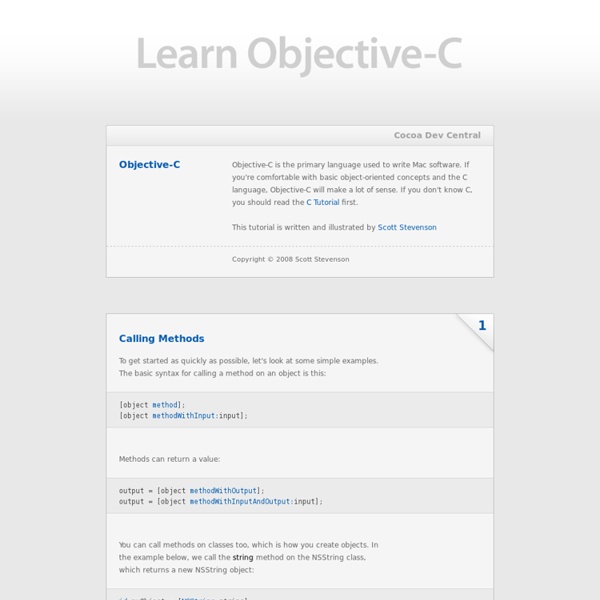



Happy Nerds - Programming Links for Kids Multithreading and Grand Central Dispatch on iOS for Beginners Tutorial Convert a slow, unresponsive app to a speedy cheetah with Grand Central Dispatch! Have you ever written an app where you tried to do something, and there was a long pause while the UI was unresponsive? This is usually a sign that your app needs multithreading! In this tutorial, you’ll get hands on experience with the core multithreading API available on iOS: Grand Central Dispatch. You’ll take an app that doesn’t use multithreading at all (and hence is very unresponsive), and convert it to use multithreading. This tutorial assumes you are familiar with the basics of iOS development. Without further ado, take a swig of soda or chew some bubble gum and begin this tutorial at the same time – and you’re already on your way to multithreading! Why Should I Care? “Ahem, so why are you telling me this? If you’re like a certain puppet, you might still be skeptical why you should care about all this multithreading business. Download the starter project, open it up with Xcode, and compile and run.
Beginning Objective-C Programming A little over ten years ago, I had just started learning object-oriented programming after spending a few years as a mental health counselor (yes, really!). What I had initially thought would be a dry and technical topic based on my days at the university turned out to be the key to an intriguing hidden world of codes and virtual universes. Programming is the key to an intriguing hidden world of codes and virtual universes What was really cool was that since computers had become so powerful and could be found everywhere in our world, programmers had suddenly become creators. Programming also served as my escape route once I decided to leave my 9-5 job and start my own company. What is Beginning Objective-C Programming? Beginning Objective-C Programming is my book that I’ve self-published originally on the How to Make iPhone Apps blog. The focus of Beginning Objective-C Programming is to teach basic programming in the simplest way possible. Table Of Contents Chapter Two: If Statements
tictactoe GNUstep.org peter/ruby_basic - GitHub Objective-C стал третим по популярности языком программирования 7 июля 2012 в 14:16 Прежде, чем вы продолжите чтение:Да, я знаю, что некоторые ставят под сомнение практическую ценность индекса TIOBEДа, я знаю, что некоторые ставят под сомнение методологию расчета индекса TIOBEтем не менее Язык программирования Objective-C продемонстрировал взрывной рост популярности и закрепился на третьей позиции индекса TIOBIE. Только зарегистрированные пользователи могут оставлять комментарии. Войдите, пожалуйста.
La programmation iPhone / Tutoriel n°1 : Pour commencer ... En guise d'introduction de notre série de tutoriels, j'ai la lourde tâche de te donner l'envie et les outils qui feront de toi un développeur iPhone de génie, un Mac Addict. Et qu'on se le dise tout de suite, quiconque entre dans l'univers Mac, de prêt ou de loin, tombe instinctivement sous le charme de la célèbre firme à la pomme croquée. Trêve de propagande, attelons nous aux pré-requis du parfait développeur iPhone. 1) Le matériel : un Mac, Xcode et le SDK d'Apple ° un MacSans aucun détour je t'annonce que pour programmer sur iPhone, il te faut absolument un Mac qui soit au minimum basé sur une architecture Intel.(amateurs de PC passez votre chemin ou faites comme moi et faites vous offrir un Mac :cool:). ° XcodeMaintenant que tu as ton Mac entre les mains, tu auras besoin de XCode. ° SDK AppleGénial tout ça, mais sans un bon SDK tu ne peux toujours pas coder . Deux options s'offrent à toi. Car l'iPhone c'est ...Un téléphone portable, et jusque là rien d'extraordinaire. . Heyfeel
A GNUstep Programming Tutorial TimeMachine Single Window Application Single window application is one of the most commonly used application type. Here, a TimeMachine application is made to demonstrate several techniques of GNUstep programming. Outlet and Action I'll write an application which show the current time with a button to update. Figure 4-1. This application is very easy. Open Gorm, choose "Document->New Application", and build a window with a title and a button. Figure 4-2. You can set the title of the button in the inspector. Figure 4-3. That's all I need to do on the interface. Now, I need an "controller" to receive the action from the "view", and display the time on the "view". First, I need to design the class of this "controller". Figure 4-4. It will show all the classes you can use. Figure 4-5. Double-click on it to change the name. Figure 4-6. Then I need a "outlet" in this class to connect to the label in the window, and an "action" which is triggered when the button is press. Figure 4-10. Figure 4-11.
java.com: Java + You